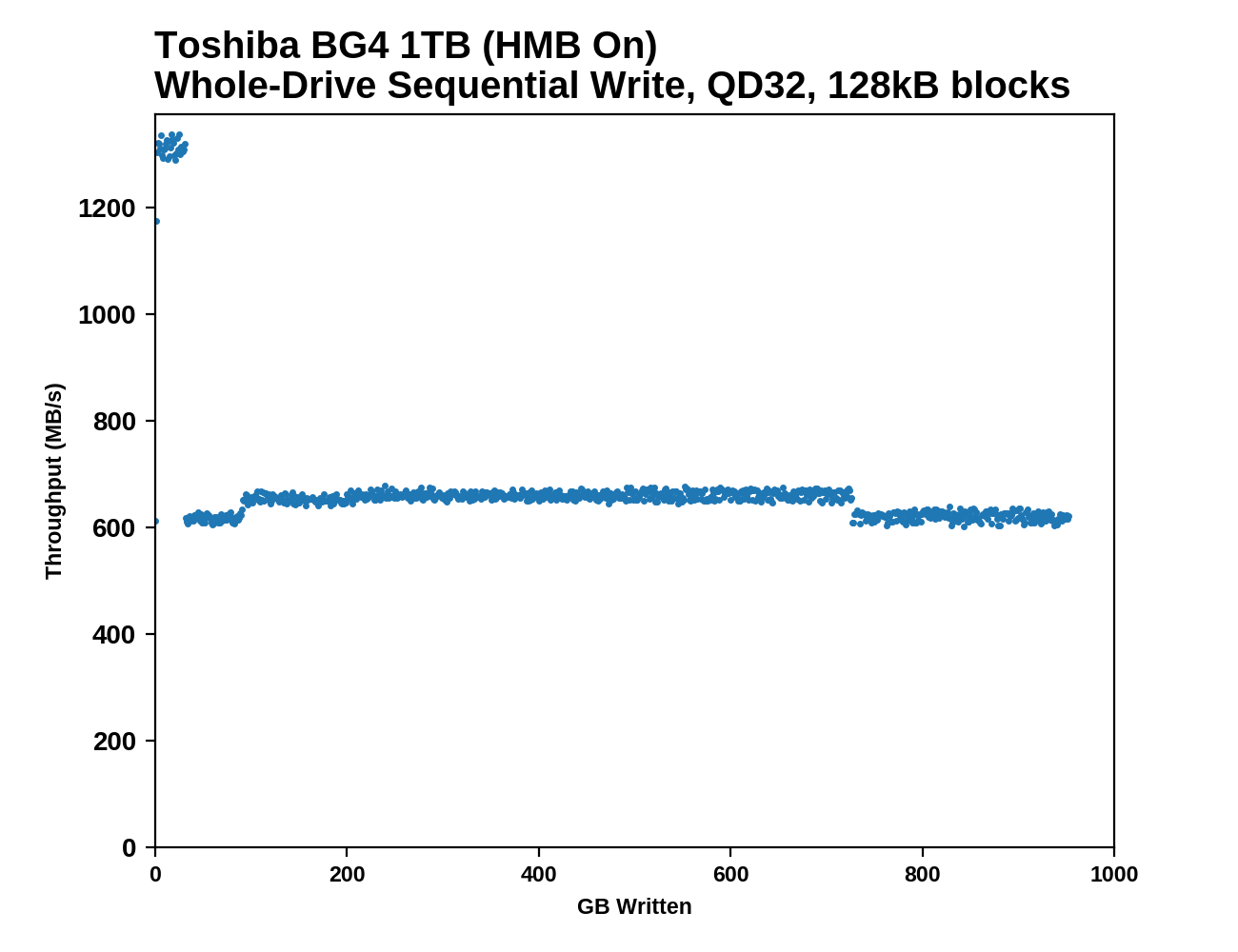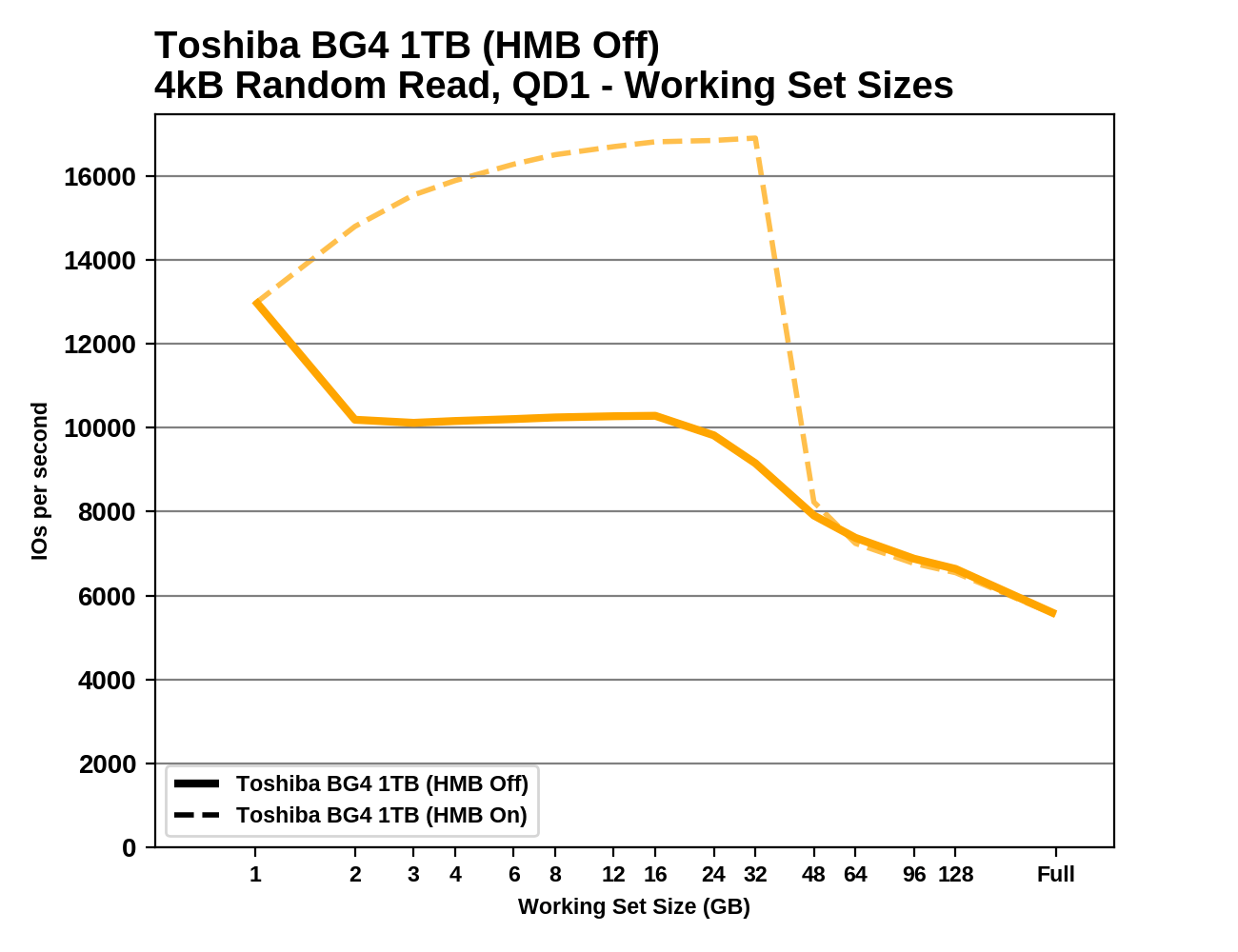The Toshiba/Kioxia BG4 1TB SSD Review: A Look At Your Next Laptop's SSD
by Billy Tallis on October 18, 2019 11:30 AM ESTWhole-Drive Fill
This test starts with a freshly-erased drive and fills it with 128kB sequential writes at queue depth 32, recording the write speed for each 1GB segment. This test is not representative of any ordinary client/consumer usage pattern, but it does allow us to observe transitions in the drive's behavior as it fills up. This can allow us to estimate the size of any SLC write cache, and get a sense for how much performance remains on the rare occasions where real-world usage keeps writing data after filling the cache.
 |
|||||||||
The 1TB Toshiba/Kioxia BG4 appears to have a 32GB SLC write cache that's far slower than what high-end NVMe SSDs provide, but still well above 1GB/s. After the cache is full, write speed is cut in half but remains steady. As expected, the Host Memory Buffer feature has minimal impact on this purely sequential workload.
 |
|||||||||
| Average Throughput for last 16 GB | Overall Average Throughput | ||||||||
After the SLC cache is full, the BG4's sequential write speed remains comfortably out of reach of SATA SSDs, but it doesn't come close to what high-end NVMe SSDs (including Toshiba's own XG series) provide. The BG3-based Toshiba RC100's write speed seriously tanked when the drive got close to full, but the 1TB BG4 doesn't suffer from that second major performance drop.
Working Set Size
Most mainstream SSDs have enough DRAM to store the entire mapping table that translates logical block addresses into physical flash memory addresses. DRAMless drives only have small buffers to cache a portion of this mapping information. Some NVMe SSDs (the BG4 included) support the Host Memory Buffer feature and can borrow a piece of the host system's DRAM for this cache rather needing lots of on-controller memory.
When accessing a logical block whose mapping is not cached, the drive needs to read the mapping from the full table stored on the flash memory before it can read the user data stored at that logical block. This adds extra latency to read operations and in the worst case may double random read latency.
We can see the effects of the size of any mapping buffer by performing random reads from different sized portions of the drive. When performing random reads from a small slice of the drive, we expect the mappings to all fit in the cache, and when performing random reads from the entire drive, we expect mostly cache misses.
When performing this test on mainstream drives with a full-sized DRAM cache, we expect performance to be generally constant regardless of the working set size, or for performance to drop only slightly as the working set size increases.
 |
|||||||||
HMB has no effect on the BG4's random read performance for working set sizes larger than about 32GB. For smaller working sets, HMB provides a big performance boost. Oddly, the performance of the BG4 gets better through the early part of this test, until the working set size gets too big. With HMB off, the BG4 seems to have enough on-controller memory to handle a 1GB working set. As compared with the older BG3-based Toshiba RC100, the BG4 seems to use a slightly larger HMB, and it gets a bigger performance boost from that extra buffer.










31 Comments
View All Comments
eek2121 - Sunday, October 20, 2019 - link
There are a few 4 TB m.2 SSDs out there, they just sell out FAST so you typically won't even find them listed. You can still find plenty of 2 TB m.2 SSDs.mxnerd - Saturday, October 19, 2019 - link
Kioxia? Great product but what a bad brand name.s.yu - Sunday, October 20, 2019 - link
No surprise coming from Japanese manufacturers recently........s.yu - Sunday, October 20, 2019 - link
Looks like the takeaway from this is although Toshiba SSDs consistently fall behind Samsungs (the main reason they're regarded as the short straw in flash lottery), they may be more efficient, but hardly anybody tests for that.discostrings - Sunday, October 20, 2019 - link
The Toshiba BG4 is actually already available in the M.2 2242 format in retail channels as the Sabrent SB-1342-2TB, SB-1342-1TB, and SB-1342-512:https://www.sabrent.com/product/SB-1342-2TB
Yes, that's right: there's a 2TB 2242 variant! I was hesitant to believe it was actually available in that capacity, as I didn't see any sort of announcement, but I received one on Thursday and I can confirm it's quite real.
Unfortunately, these aren't useful for most current laptops with 2242 slots (that are primarily included for WWAN but which can also use NVMe drives like the RC100). As these SSDs use four PCIe lanes, they require the M key, while all laptops that I know of direct two (or less) PCIe lanes to the 2242 slot, and thus have a B key that prevents use of these drives.
So there probably won't be much of a market for these until there are laptops out with M-keyed M.2 2242 slots. It would be great to see a 2-lane variant with a B key in the short term for use in current laptops.
discostrings - Sunday, October 20, 2019 - link
I mixed terminology up a little bit in my prior post. The Sabrent drives use Toshiba BiCS4 NAND (which is also used by in the Toshiba BG4), but these are not rebranded variants of the same drive. Apologies for any confusion.peevee - Monday, October 21, 2019 - link
So they already have brands Toshiba, Lite-On and Plextor, all pretty valuable and respectable (esp Plextor I think), why do they feel like they need another one?Billy Tallis - Monday, October 21, 2019 - link
The decision to rebrand from Toshiba to Kioxia was made before the decision to buy Lite-On's SSD business. Continuing to use the Toshiba brand name long-term isn't an option since they aren't part of the Toshiba conglomerate anymore and need to IPO under a name they own. They don't get to use the Lite-On name either because they didn't buy the whole company, just the SSD portion. They might now own the Plextor brand.Targon - Monday, October 21, 2019 - link
If the laptop maker has a decent design, then it would make more sense to go with a small capacity SSD to keep the laptop price down and then put a better SSD in yourself. Get something with a normal 1TB hard drive but has the support for NVMe, and you then throw in a 1TB drive yourself. No need to feed the stupidity of people wanting a tiny machine that has a slow processor just to keep power demands low. Going with even a 35 or 45 watt CPU with a 15 inch display will give you a much more powerful laptop than these 15W CPU machines with a 11 inch screen designed for people who sit in meetings all day but have much lower performance.At least we are beyond the days of Intel Atom crap machines in that space.
MykeM - Thursday, October 31, 2019 - link
You can actually get a external USB-C SSD that uses this particular Toshiba BG4 SSD. It’s made by CalDigit know for its excellent Thunderbolt 3 docks. It’s called Tuff Nano and at the moment only comes in the ½ terabyte capacity. The read speed is just over 1GB/s (if the device USB-C supports USB3.x Gen2). And it’s tiny:l:https://www.caldigit.com/tuff-nano